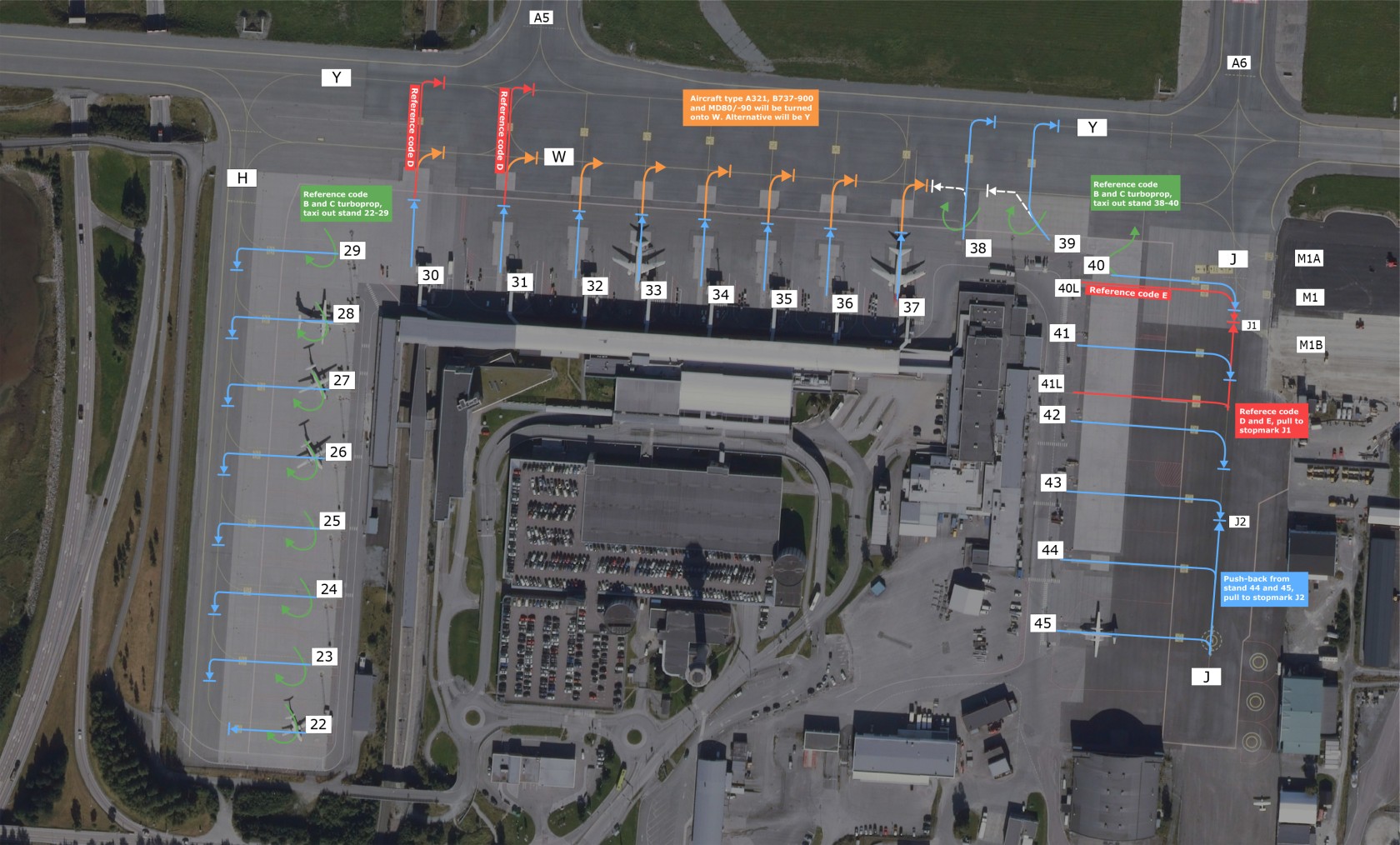ENVA – Trondheim Værnes
Overview
Welcome to Trondheim! Home of the most flown domestic city pair together with Oslo. Also the home of "Hell", great moustache styling and rock. But do not forget the airport. It is the 3rd busiest airport in Norway as it is a domestic hub for commuters to the smaller airports in Norway. Trondheim host also several flight towards nordic and European destinations.
Stands
| Stands | Assigned to |
|---|---|
| 23-29 | Commuter Domestic |
| 30-37 | Domestic flights |
| 40-44 | International flights |
| Apron | Assigned to |
|---|---|
| M1 | De-Ice Pad |
| M2 | GA |
| M3 | GA Ambulance flights |
| M4-M6 | Military parking |
IFR clearance
Initial contact is with Ground, reporting callsign, stand number, and latest ATIS identification letter and QNH
Push-back
Most of the terminal gates requires straight-back pushes, however a few have turn-pushes. If you are not sure how pushback is excecuted from your stand, please have a look on the pushback maps witch will show how we want you to perform the pushback.
Pushback maps
Taxi
Taxi instructions normally contains the full taxi route, however the runway intersection is not always included. If for example “holding point runway XX” is stated in your instruction, you may call ATC with “CALLSIGN, ready via ” as you approach this intersection, and it may be approved if traffic permits. Make sure to double-check if you are able to use the runway length from the intersection before requesting it.
SIDs
All SIDs are individually numbered for each runway. When receiving your clearance, know that the SID stated is only valid for one runway, in case the controller forgets to state the departure runway. RNAV SIDs (including OMNI-departure) has an initial climb altitude of 6000 ft. If you are unable to follow the published SIDs (old AIRAC, default or non-database freeware aircraft, etc.), request an Omni-directional departure. It is important that you NEVER climb above the initial climb without ATC clearance, as STARs and SIDs cross each other at different altitudes.
STARs
Trondheim Værnes is using a “Point Merge System”, or PMS for all arrivals. This means that all STARs end up in a “fan” made out of waypoints (study the STAR charts), in which pilots should always be prepared for a direct routing towards the merge waypoint, 4 in total, in order to ease the workload of approach ATC.
The last fix of the STAR (or Merge Point) is followed by a transition to the ILS approach for each runway. ATC often replace these with vectoring, but always be prepared to fly the transition, and do NOT fly direct from the merge point to the Final Approach Fix. If you have no transitions available, inform ATC and request vectoring. Study the approach charts, and make sure to always follow altitude and speed restriction, unless otherwise instructed by ATC
⚠️Recommended descend restrictions
All STARs to Trondheim are by standard giving a descend profile, based on flying along the STAR throughout. In almost all situations, a DCT to STAR merge point will be given. Therefore a set of recommended altitudes at given points is added to charts and text pages to guide and give an optimum descend profile to the approach. We highly recommend programming this in FMS/FMC in good time prior to your top of descend and pre-program your expected STAR
Runway 09
| Designator | Recommended Altitude |
|---|---|
| MIVSO xL | Cross VA414 at 7000 ft |
| NELSU xL | Cross VA414 at 7000 ft |
| NUPGO xL | Cross TUDLU at 7000 ft |
| VEVOD xL | Cross NEDIV at 7000 ft |
Runway 27
| Designator | Recommended Altitude |
|---|---|
| MIVSO xL | Cross ADEXA at FL 90 |
| NELSU xL | Cross ADEXA at FL 90 |
| NUPGO xL | Cross ALENU at FL 90 |
| VEVOD xL | Cross ADEXA at FL 90 |
Approach
The default approach to Værnes is ILS for all runways. RNAV or visual approaches are available on request.
Visual approach is usually flown via MALOV (Runway 09) and TUSMO (Runway 27).
Direct routings
In Norway, direct routings are often used. Both arriving and departing traffic should be prepared to fly direct the end of SIDs, STAR Merge Points, and airspace border fixes. Make sure you have your filed route and waypoint page available to quickly accommodate direct routings.
Communications
You can always check online positions and sectors by visiting vatglasses.uk
ENVA_ATIS – Værnes ATIS – 127.550
ENVA_GND – Værnes Ground – 121.600
ENVA_TWR – Værnes Tower – 119.400
ENVA_APP – Værnes Approach – 118.600
ENVA_D_APP – Værnes Director – 119.150
ENBD_CTR – Polaris Control (Bodø ACC) – 126.450
ENBD_S_CTR – Polaris Control (Oslo ACC south) – 125.700
ENBD_C_CTR – Polaris Control (Bodø ACC central split) – 118.550
ENOR_SC_CTR - Polaris Control (Bandbox South Central/ENSV+ENOS+ENBD_S) - 134.515
ENOR_CTR - Polaris Control (Bandbox) - 125.500
ENRC_N_CTR - Værnes Tower (Bodø Remote Tower Center) - 118.325


